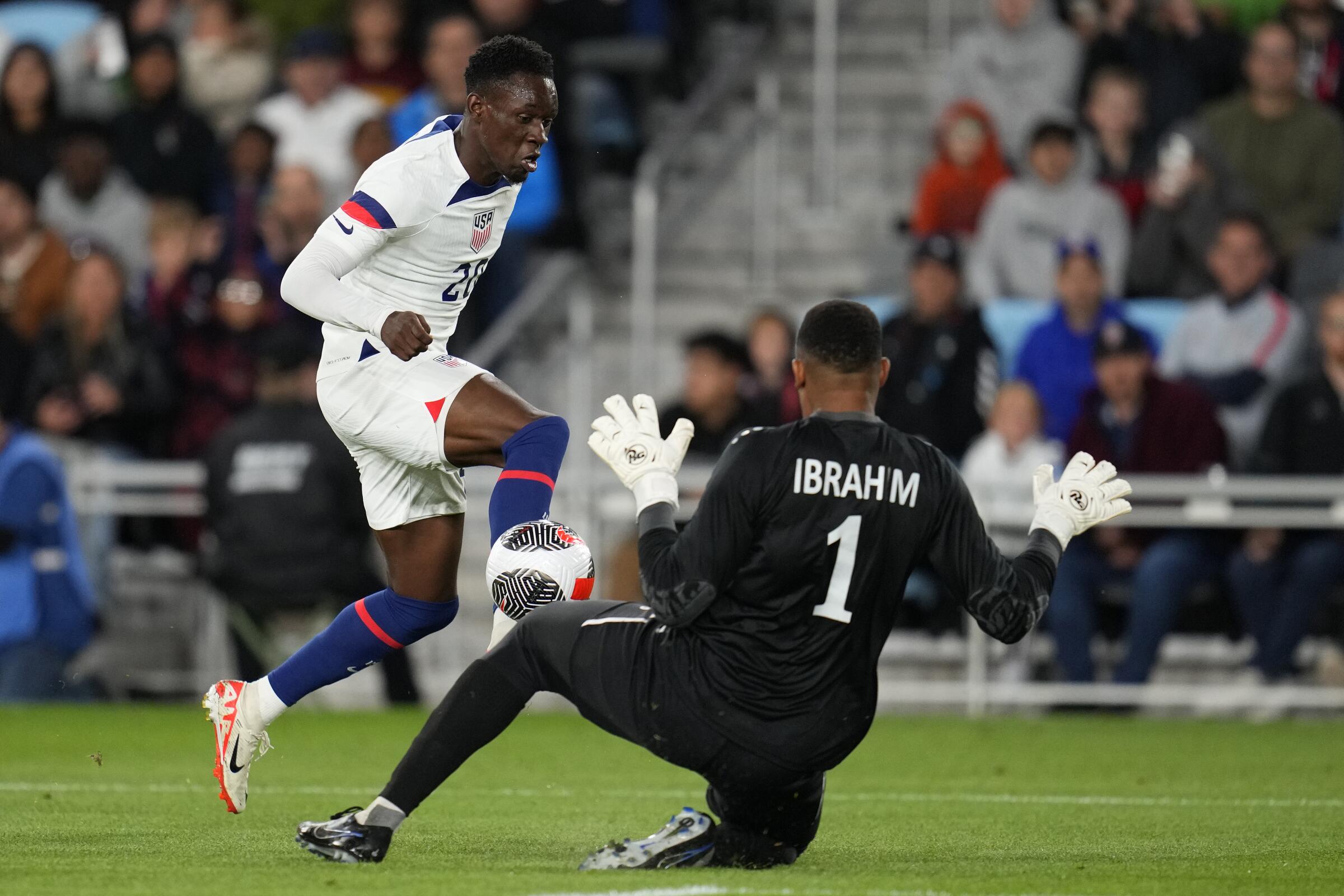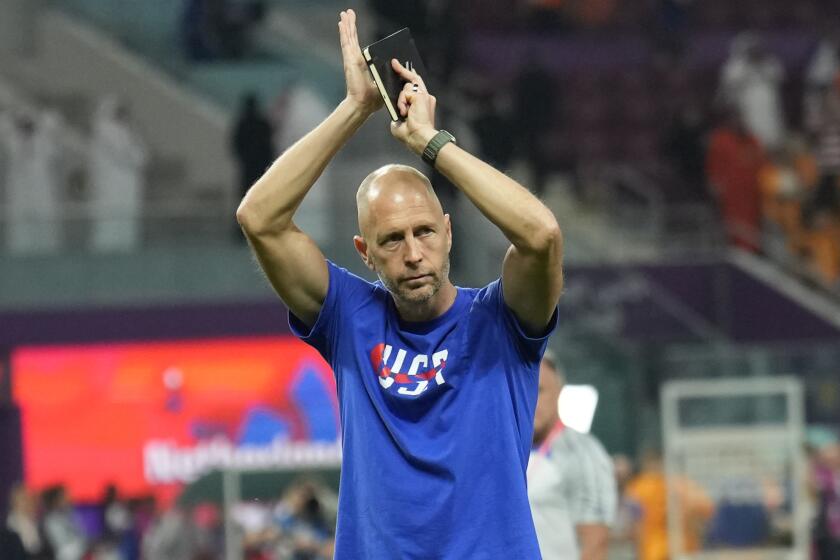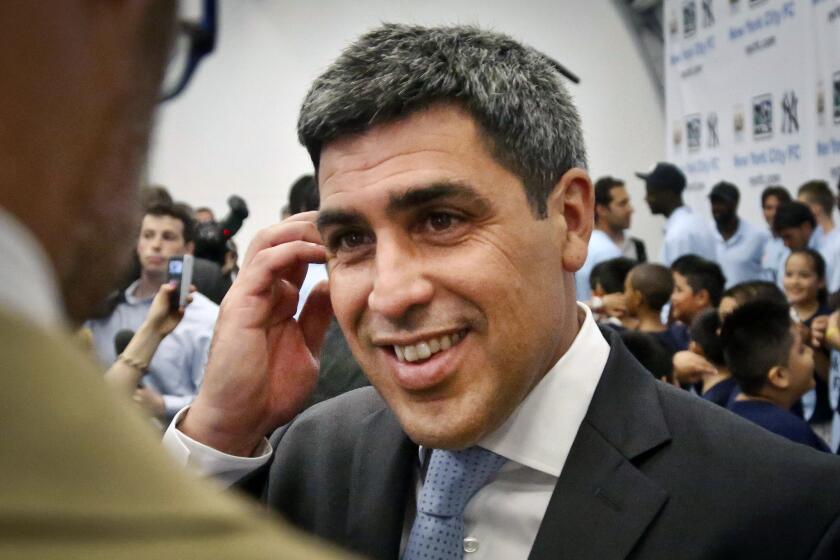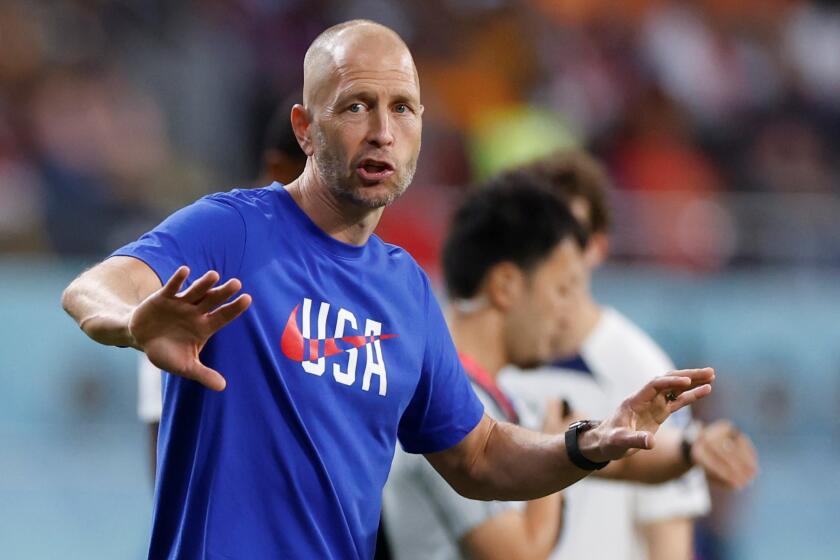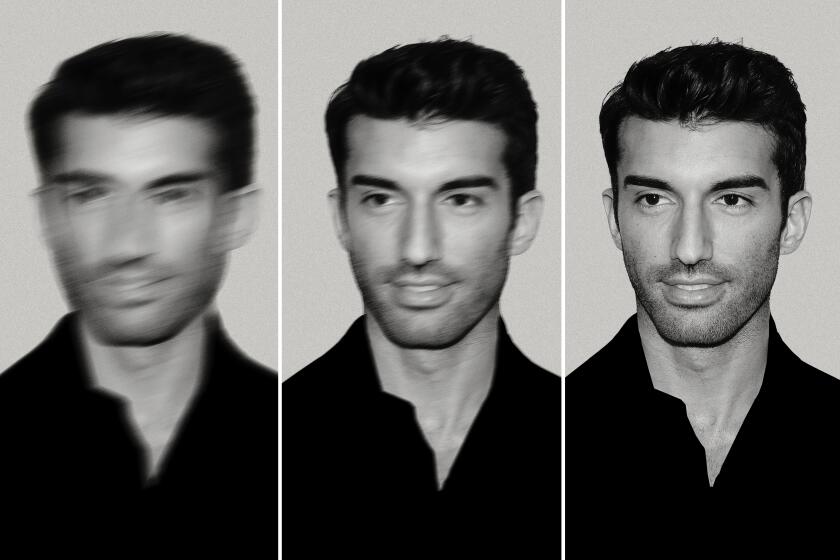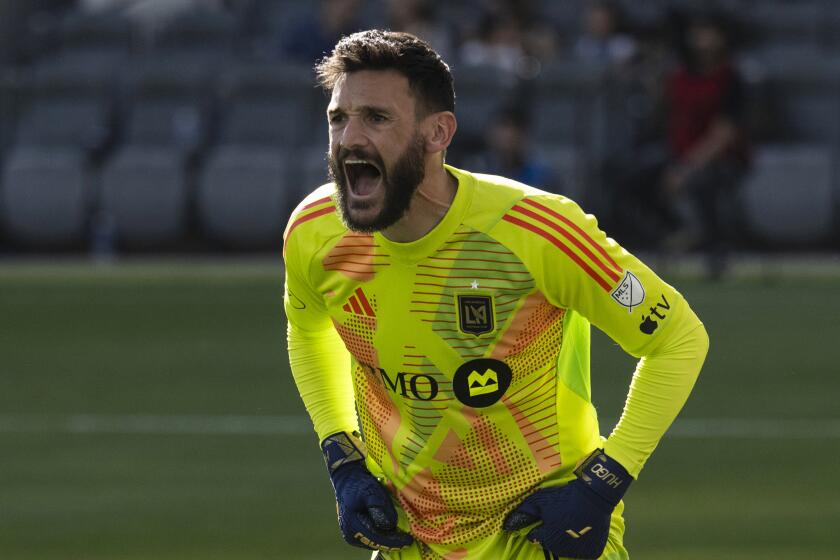Kevin Baxter writes about soccer and hockey for the Los Angeles Times. He has covered seven World Cups, five Olympic Games, six World Series and a Super Bowl and has contributed to three Pulitzer Prize-winning series at The Times and Miami Herald. An essay he wrote in fifth grade was voted best in the class. He has a cool dog.
- Share via
1
Gregg Berhalter’s second stint as coach of the USMNT got underway this month and so far the new rollout — call it Berhalter 2.0 — looks a lot like the first version.
The team was successful if underwhelming, beating Uzbekistan and Oman by a combined 7-0. The U.S. largely stuck with its default 4-3-3 formation and built cautiously out of the back. It also appeared uninspired at times and seemed to play down to the competition — it led 85th-ranked Uzbekistan 1-0 going into stoppage time — which were also hallmarks of Berhalter’s first four years.
But there are reasons to believe this version will be better than the last one.
For starters it’s deeper and younger. Folarin Balogun, whose goal against Oman was his second in four games with the U.S., finally gives Berhalter the world-class striker he has lacked. Behind him, Ricardo Pepi continues to mature and improve, scoring six times in his last six games, with four of those goals coming off the bench.
“You always want your forwards scoring goals. Our job as teammates and as coaches is to put them in a position to score,” Berhalter said. “As far as we see the competition, it’s twofold, right? It’s what they do for their clubs each and every week, and what they do for us when they’re in camp.”
After U.S. Soccer reviewed allegations of domestic violence, it is bringing Gregg Berhalter back to coach the men’s national team.
Neither player has turned 23 yet, which also goes for four of the other nine starters against Oman. The core is young: Captain Christian Pulisic just turned 25 Monday, the same age as Weston McKennie. Tyler Adams, the captain in the last World Cup, is 24. Gio Reyna and Yunus Musah are both 20. And Berhalter continues to widen the youthful player pool below them; when teenager Ben Cermaschi and 20-year-old Kevin Paredes came off the bench in the final 20 minutes, they became the 58th and 59th players to make their national team debuts in his 62 games as coach.
The team is also getting more continental as well.
Kristoffer Lund, a Danish-born dual national, appeared in both games at outside back for his first two senior international caps. He had 85 touches in 90 minutes against Oman. But more significantly, he was one of just five dual nationals — alongside Balogun, Malik Tillman, Musah and Sergiño Dest — who spent the majority of their lives living and playing in Europe. Berhalter, who has prioritized the recruitment of dual nationals, has used more than three dozen since taking over the USMNT in 2019.
All these transformations in the national team’s player pool now leave Berhalter with a unique opportunity to transition from the predictable, plodding attacking style he has used to a quicker more aggressive one with Balogun (or Pepi) as the target striker in front of Pulisic and Tim Weah with Reyna, the playmaker, in the middle.
Voices
Commentary: Threats and mudslinging. Damage caused by Gio Reyna’s parents will haunt U.S. Soccer
A report commissioned by U.S. Soccer proves Gio Reyna’s parents went too far in trying to bring down USMNT coach Gregg Berhalter.
Behind them Adams, who is still recovering from a hamstring injury, is well-suited to play as a space-eating holding midfielder with McKennie, probably the best player in the September camp, going box to box. That’s what Berhalter 2.0 should look like: a dynamic 4-2-3-1.
“We’re still trying to figure out the best way to utilize Balo, because we know he’s high quality,” Berhalter said of Balogun, who scored while playing as lone striker for club team Monaco over the weekend. “We want to put the forwards in position where they can score.”
There are obstacles to making that happen, of course, chief of which is the return of the oft-injured Reyna. He played for interim coach B.J. Callaghan during Berhalter’s absence this summer, sustaining a leg injury during the CONCACAF Nations League final. He only recently returned to the field with Borussia Dortmund’s U-23 team, leaving his fitness for a call-up for the USMNT’s October friendlies in doubt.
First, however, Berhalter and Reyna need to meet to clear the air. The player’s immature pouting over playing time at last fall’s World Cup, some ill-advised comments from Berhalter and a lurid campaign by Reyna’s parents to damage the coach’s reputation put Berhalter’s future with the national team on hold for six months while U.S. Soccer sorted things out.
As the coach, Berhalter must take the initiative to make things right. It’s been two months since he was reinstated; why he hasn’t met with Reyna already is a mystery. The longer he waits, the more it remains an issue.
Rebuilding a relationship with Reyna could also help placate the sector of the fan bases that has inexplicably sided with Reyna, who was such a distraction in Qatar he was nearly sent home.
U.S. men’s soccer coach Gregg Berhalter called up a mix of World Cup veterans and less experienced players for friendlies, notably omitting Gio Reyna.
For reasons I don’t quite understand, Berhalter remains extremely unpopular among the supporters. Perhaps that comes with the job; Jurgen Klinsmann was also loathed, as was Bob Bradley before him. It certainly can’t be based on performance since Berhalter (39-11-12) has the best winning percentage in USMNT history of any coach who worked more than seven games, while Klinsmann and Bradley rank behind only Bruce Arena in terms of victories.
What matters more, however, is the fact the players like Berhalter and want to play for him. The core of the young team came up under him, believe in him and have influenced the culture he has adopted. That loyalty is rare, even if it doesn’t extend to the fan base, and it has come along at the right time.
The next World Cup, which the U.S. will host alongside Mexico and Canada, will be the most important in the program’s history. More people will be watching and more sponsors will be spending than ever before and to capture that attention — and a majority of those dollars — the U.S. will need to field a competitive team capable of making a deep run in the tournament.
To do that the team will have to continue growing and progressing and moving away from a playing style that has become far too staid. The wins over Uzbekistan and Oman weren’t real tests for the U.S.; the October fixture window, with games against Germany and Ghana, will provide a much better indication of where the team is as it looks ahead to November’s Nations League quarterfinals and next summer’s Copa America.
Berhalter 2.0 still has quite a few bugs that need to be worked out but the first trial left Berhalter feeling optimistic.
“I really liked the mindset of the guys, the intensity of the group,” the coach said. “Overall. I’m pleased with the camp.”
⚽ You have read the latest installment of On Soccer with Kevin Baxter. The weekly column takes you behind the scenes and shines a spotlight on unique stories. Listen to Baxter on this week’s episode of the Corner of the Galaxy podcast.
